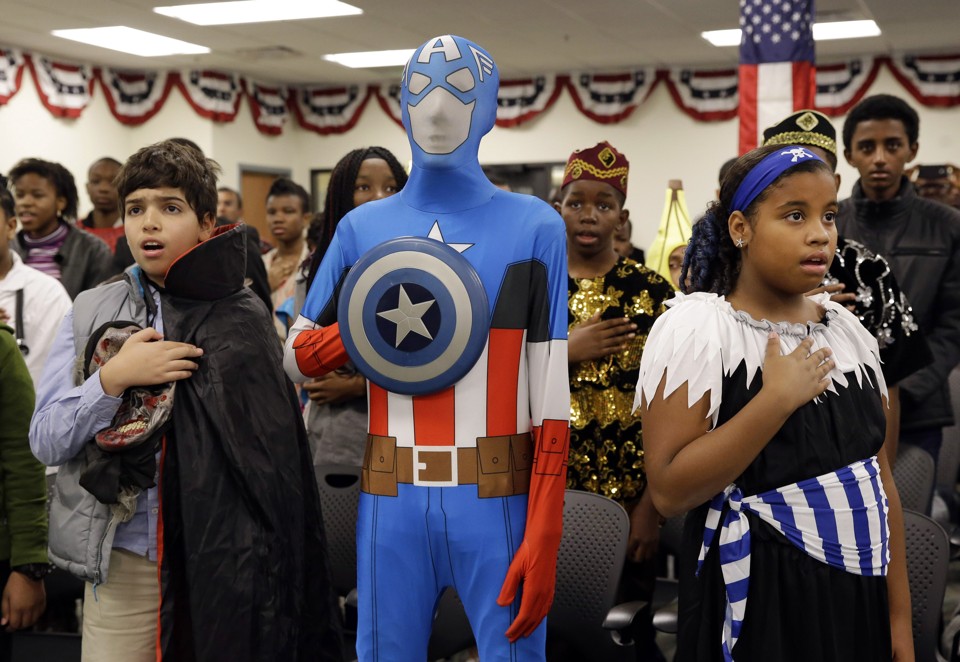Education Secretary Duncan Combats School-to-Prison Pipeline
Duncan to urge states to find paths other than incarceration for people convicted of nonviolent crimes.

Secretary of Education Arne Duncan greets a Los Angeles-area principal last year. Duncan is slated to give a major speech aimed at curbing the school-to-prison pipeline Wednesday.
He was looking to curb the number of students who were going to jail, and assumed an early intervention program would be needed after school let out, the time he assumed most students were running into trouble.
He was stunned to learn, however, that the majority of arrests were occurring during the school day, in the schools themselves.
“Those calls to the police, to put kids in jail? We were making them,” Duncan is expected to say in a speech Wednesday at the National Press Club. “We were responsible. We had met the enemy, and it was us.”
Today, schools refer a quarter of a million students to the police each year, according to the U.S. Department of Education, a majority of which are boys of color and students with disabilities.
In a major speech aimed at curbing the school-to-prison pipeline, Duncan is slated to urge states and local school districts to find paths other than incarceration for people convicted of nonviolent crimes, something that the department says could save upwards of $15 billion each year. Then, using that savings, increase the pay for teachers working in the country’s highest-need schools.
That’s enough funding, the Education Department estimated, that if each state focused on its schools with the highest poverty rates, it would be able to increase teacher salaries by at least 50 percent.
“I’ve long said great teachers deserve to be paid far more,” Duncan is set to say. “With a move like this, we’d not just make a bet on education over incarceration, we’d signal the beginning of a long-range effort to pay our nation’s teachers what they are worth.”
Another way states could use their savings that Duncan is expected to outline: Create five positions at each states’ highest poverty schools for accomplished teachers who would mentor their peers received in return $25,000 pay increases. That, the department estimated, would cost just a quarter of the $15 billion in savings.
Of course the department doesn’t have the authority to require states or local school districts to implement such changes, and it’s unclear what sort of carrots it has left, if any at this point in the twilight of the administration, to incentivize states to adopt those changes. Nonetheless, Duncan urged them to be more creative in how they deal with young people convicted of nonviolent crimes.
“We cannot lay our incarceration crisis at the door of our schools,” Duncan plans to say. “But we have to do our part to end the school to prison pipeline.”
More than two-thirds of state prison inmates are high school dropouts, according to the department. And an African-American male between the ages of 20 and 24 without a high school diploma or GED has a higher chance of being imprisoned than of being employed.
Earlier this September, Duncan visited an Illinois prison where he met with several young men who were incarcerated for a variety of crimes they had committed in their childhood.
“Many of them told us that from an early age they had to take care of their families, lacked meaningful job options, and felt completely alone in a world where nobody seemed to care about or believe in them,” Duncan is expected to say. “Every day, as a society, we allow far too many young people to head down a road that ends in wasted potential. Sometimes, we are complicit in the journey.”
Creating additional support systems for disadvantaged students, especially for young men of color, and neighborhoods hampered by violence has been a major priority for the Obama administration. Through programs like My Brother’s Keeper and Promise Neighborhoods, the administration has tried to provide resources to cash-strapped school districts with overburdened social workers and other critical support staff.
Duncan’s announcement Wednesday comes as many under-resourced schools are relying more on police rather than teachers and administrators to maintain discipline, and a growing number of districts are employing school resource officers to patrol hallways.
Policy groups were slow to respond to Duncan’s proposal Wednesday, but several civil rights groups, including the American Civil Liberties Union have already been looking at ways to slow the school-to-prison pipeline through negotiating memorandums of understanding between local school districts and authorities.
Todd Cox, a senior fellow at the Center for American Progress, a left-leaning think-tank, agreed that lack of opportunity too often puts people on a path into the criminal justice system.
“It is critical that we make removing barriers to these opportunities a priority if we are going to ultimately stem the tide of mass incarceration,” he said.






